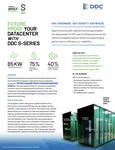US President Donald Trump used his joint address to Congress to further criticize the CHIPS and Science Act, telling lawmakers they should “get rid of [it].”
His comments come a day after TSMC announced plans to invest around $100 billion into US chip manufacturing following the president’s threat to put “100 percent tariffs” on foreign semiconductors.
“Your CHIPS Act is a horrible, horrible thing. We give hundreds of billions of dollars and it doesn’t mean a thing. They take our money and they don’t spend it,” Trump said in his speech.
Seemingly referring to his new proposal to boost US chip manufacturing, he continued: “We’re giving them no money. All that was important to them was they didn’t want to pay the tariffs. So they came and they’re building. And many other companies are coming. We don’t have to give them money, we just want to protect our businesses and our people, and they will come because they won’t have to pay tariffs if they build in America. So it’s very amazing.”
Trump concluded his comments by saying: “You should get rid of the CHIPS Act and whatever’s left over, Mr. Speaker, you should use it to reduce debt or any other reason you want to.”
The $280bn CHIPS and Science Act, was approved by Congress in July 2022, with $52bn of the overall funding package designated as subsidies for US semiconductor manufacturers. Funding from the act has also been earmarked for semiconductor R&D, growing a skilled semiconductor workforce, and incentives for manufacturing chips and specialized tooling equipment.
According to the Semiconductor Industry Association (SIA), during his time in office, former President Biden announced around $32.5 billion in CHIPS and Science Act grant awards, and up to $5.5bn in loans to 32 companies across 48 projects in 23 states.
These projects include total investments of more than $380bn over two decades, with the majority to be invested by 2030. The projects are expected to create more than 145,000 new jobs – around 43,000 manufacturing jobs and 102,000 construction jobs.
However, President Trump has long criticized the Biden-era initiative, instead arguing that tariffs are the best way to incentivize chip companies to bring manufacturing back to the US. Tariffs are paid by the importer and not the exporter.
On average, it takes around three to four years to build a new chip fab, but large projects like TSMC's previously planned Arizona fab have been hit by delays and worker shortages.
In July 2023, TSMC announced it was delaying its Arizona fab due to struggles with finding enough skilled workers to open on time.
The company was also hit with a lawsuit in 2024 after more than a dozen current and former TSMC employees alleged the company had engaged in “anti-American” discrimination by favoring Taiwanese workers over US hires.
Such claims included TSMC’s alleged preference for employees who have an understanding of Mandarin Chinese, and allegations that the company hired an “Asian headhunter” so it could find Taiwanese candidates to interview for US job roles.
Elsewhere this week, it has been reported that DOGE-led staffing cuts removed around two-thirds of CHIPS staffers working on research and development, and 57 percent of workers focused on incentives for semiconductor infrastructure.
GovExec reported that 73 probationary workers at the National Institutes of Standards and Technology have had their roles terminated, of which 42 were hired based on provisions within the CHIPS and Science Act.
This is despite a judge ruling this week that the justification for firing probationary workers within government departments was unlawful.







